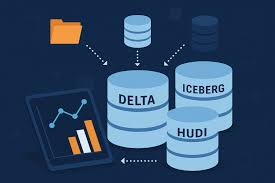As organizations increasingly shift toward modern data lakehouse architectures, the choice of an open table format has become a critical decision. The three leading contenders—Apache Iceberg, Delta Lake, and Apache Hudi—offer distinct advantages and trade-offs. Each provides solutions for challenges like data versioning, schema evolution, transaction consistency, and query optimization. In this article, we’ll break down the differences, highlight use cases, and provide clarity on how to approach an apache iceberg delta lake hudi comparison for your business.
Understanding the Lakehouse Formats
- Apache Iceberg was designed to address long-standing problems with Hive tables. It introduces a high-performance, open standard for managing large analytic datasets with features such as hidden partitioning, snapshot isolation, and schema evolution.
- Delta Lake, originally developed by Databricks, focuses on bringing reliability to data lakes through ACID transactions and tight integration with Spark. It is widely used in enterprise environments that rely on Databricks’ ecosystem.
- Apache Hudi emphasizes incremental data processing and upserts, making it a strong choice for streaming and near real-time use cases. It allows users to ingest data continuously while still enabling queries without heavy batch jobs.
Key Features and Strengths
- Schema Evolution and Management
- Iceberg: Provides robust schema evolution without rewriting entire tables.
- Delta Lake: Handles schema evolution but can require manual steps in certain scenarios.
- Hudi: Supports schema evolution but shines more in incremental processing.
- Transaction Handling
- Iceberg: Offers snapshot-based isolation, ideal for batch and streaming reads.
- Delta Lake: Strong ACID transaction guarantees, especially effective in Spark-driven workloads.
- Hudi: Focused on upserts and deletes, well-suited for mutable data pipelines.
- Performance and Query Optimization
- Iceberg: Optimized for engines like Spark, Flink, Trino, and Presto, with advanced partitioning strategies.
- Delta Lake: Excellent performance within Databricks and Spark environments, but less versatile outside.
- Hudi: Great for incremental queries and CDC (Change Data Capture) pipelines.
When to Choose Iceberg, Delta Lake, or Hudi
- Choose Apache Iceberg if you need an open, flexible format that works across multiple query engines and cloud providers. It’s a strong option for teams prioritizing scalability, interoperability, and robust schema management.
- Choose Delta Lake if your workloads are Spark-heavy and you want a proven solution with enterprise support, especially within Databricks. It’s ideal for organizations that prioritize reliability and ACID compliance for large-scale analytics.
- Choose Apache Hudi if your focus is on streaming, incremental updates, or real-time data ingestion. It’s a natural fit for businesses that rely on fast, continuous data processing with frequent upserts or deletes.
The Future of Open Table Formats
The competition among these formats is shaping the future of data lakehouses. Increasingly, companies are adopting multi-engine ecosystems, which makes interoperability more valuable. Iceberg’s neutrality and growing community support are pushing it into the spotlight, while Delta Lake continues to evolve with strong Databricks backing. Meanwhile, Hudi is carving a niche in real-time analytics.
Ultimately, there’s no universal winner. Your choice depends on infrastructure, team expertise, and workload requirements. Conducting a thorough apache iceberg delta lake hudi comparison based on your business needs is the best way to ensure long-term success in your data strategy.
Conclusion
The rise of the lakehouse paradigm reflects the need for flexibility and reliability in managing big data. Apache Iceberg, Delta Lake, and Apache Hudi each bring unique strengths to the table. By carefully considering schema handling, transaction guarantees, performance, and real-time requirements, organizations can select the format that aligns best with their goals.

